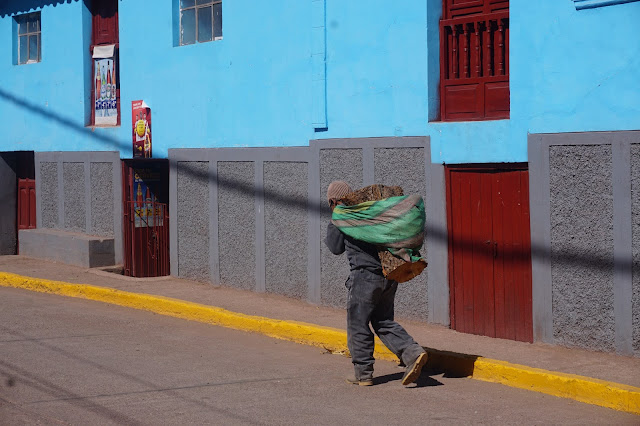June 22, 2016
Today were visited two small towns- Chinicheros a town of Inca origin mostly known for it's women's weaving cooperatives and Maras, a town of farmers that also mine salt using a four century old technique and salt ponds that were built by the Incas. Near Maras are the Moray Ruins, a very interesting set of Inca terraces.
 |
This smiling woman is the president of this local cooperative and has travelled to the US and other parts of the world to share the traditional weaving techniques of her people.
She is committed to maintaining this beautiful art. |
 |
| First the animal (primarily alpaca) must be sheared, then the fibers washed. |
 |
| The women grate a root to make a soapy solution that will clean the wool in order to be spun into a fine yarn. |
 |
The spinning is a difficult and tedious technique that is the most time consuming part of the finished product.
Girls are taught this beginning around age 6 in order to perfect their technique. |
 |
Every color is made from organic products- leaves, roots, soil, berries, fruits, bugs-
the yarn is dyed in pots and then urine is used to set the color.
The women claim that only children's urine under the age of 6 is "good". |
 |
The women then wind (I think "warp" is the correct term) the yard around a frame, stake one one to the ground and loop a strap around their backs then begin actually weaving the beautifully intricate and colorful designs.
It is truly an art!!! |
**While visiting the weavers co-op we were quickly escorted to a side yard by Polizia...
the women were being visited by an important North American- Jill Biden... we caught a glimpse of her as we came out the adjacent building's door!
Maras, home of the Moray Ruins is just a short drive away with beautiful views of the glacier capped Andes range and the small farms that dot the landscape like a patchwork quilt.
 |
Unfortunately, plans are in place to repurpose this strip of land for a new international airport...
In the next 7 years, tourists will no longer have to fly to Cusco but can arrive directly into the Sacred Valley. |
 |
| Local farmer (notice that this is a female)- |
 |
Moray Ruins-
These are the only completely circular terraces built by the Incas that have been found.
It is thought that the Incas used these for "experiments" in growing crops at different altitudes- a sort of Incan laboratory! |
 |
Stairs that take you down about 1000 feet-
as we descended we noticed that it became considerably warmer... |
A boxed lunch with a special box for "Mrs. Nash"
 |
| First view of the Salt pans |
 |
Farmers at work...
The "pans" which are only about 8-10 centimeters deep,
are fed through carefully carved channels from a natural underground spring that has 52% salt content.
The sun evaporates the water leaving the salt behind. |
 |
| Walking amongst the pans is a tricky feat requiring sure-footedness and a great sense of balance! |
 |
| The "raw" salt |
 |
The dried salt is chiseled up from the pan and loaded into bags weighing 50 kilo bags-
we couldn't budge them... much less carry them along the steep and narrow paths up the mountain... |
 |
but this seasoned Peruvian porter can!!
He hauls the bags up one by one up to the storehouse at the top of the mountain. |
 |
| This "family" of farmers are taking a lunch break |
 |
| Our walk back down to the valley- |
 |
Although we are in the Andean Highlands, it is still considered a sub-tropical climate
& colorful birds frolic in the gardens of our hotel. |
 |
A nice break in the pool!
(our first for the trip) |



































































